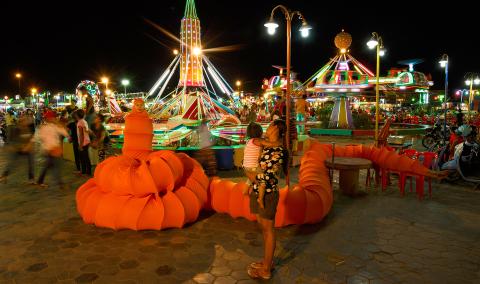APT8–9
The Asia Pacific Triennial of Contemporary Art
'The 8th Asia Pacific Triennial of Contemporary Art' (APT8)
Presented in 2015–16, APT8 was driven by an instinct that performance and the body were a major element of contemporary art practice in the Asia Pacific region. The rise in prominence of figuration and performance felt like a return to aspects of the Triennial’s founding years, which spurred the revival of its conference and the introduction of APT Live — a program of performance coinciding with APT8’s five-month season.
We returned to China, where curators looked beyond traditional art centres, and visited Mongolia and Nepal for the first time. The project Kalpa Vriksha: Contemporary Indigenous and Vernacular Art of India focused on the works of indigenous Indian (Adivasi) artists, who continue to struggle for inclusion in broader contemporary art discourse. APT8 was also coloured by a rising generation of young artists in Cambodia, emboldening freedoms in Myanmar and, in Japan, a continuing response to the 2011 Fukushima disaster. Performance was key to the exhibition’s Pacific dimension, with a community-based multi-artist project co-curated by Marcel Meltherorong (Yumi Danis (We Dance)). And for the first time, the Gallery assembled an Indigenous Advisory Group to provide feedback on APT projects that had Aboriginal or Torres Strait Islander content or could benefit from guidance relating to cultural protocols. APT8 Cinema focused on independent filmmakers in the Philippines in Filipino Indie, co-curated by Yason Banal, and the broad experiences of contemporary Islam in Pop Islam, co-curated by Khaled Sabsabi. APT8 Kids’ activities continued to provoke a sense of inquiry about the people and places of the region.

Anida Yoeu Ali’s APT8 performance under Haegue Yang’s installation in the QAG Watermall, QAG, 2015 / © The artist / Photograph: Joe Ruckli, QAGOMA
APT8 Highlights
Anida Yoeu Ali’s surreal live performance of her video work The Buddhist Bug, Into the Night 2015 intrigued at the opening weekend, and visitors watched as Melati Suryodarmo undertook the 12-hour endurance performance piece I’m a Ghost in My Own House 2012, in which she crushes and grinds hundreds of kilograms of charcoal briquettes into powder by hand. Abdul Abdullah’s twist on traditional wedding photography highlighted racial and cultural inequalities; Haegue Yang’s conceptual installation in the Watermall used Venetian blinds to create the optical illusion of a motion blur and touched on ideas of abstraction and the conceptual art of Sol Lewitt. David Medalla’s Cloud Canyons No.25 1963/2015 enchanted visitors with endless cylinders of foam, while Wiradjuri artist Brook Andrew immersed us in a renewed vision of the Gallery’s Australian art collection at QAG.

Anida Yoeu Ali / Cambodia/USA b.1974 / The Buddhist Bug, Into the Night (still) 2015 / A project of Studio Revolt. Concept and performance: Anida Yoeu Ali; Video: Masahiro Sugano / Commissioned for APT8. The Kenneth and Yasuko Myer Collection of Contemporary Asian Art. Purchased 2015 with funds from Michael Sidney Myer through the QAGOMA Foundation / Collection: QAGOMA / © Anida Yoeu Ali
APT8 artists included Richard Bell, Kiri Dalena, Juan Davila, Gunybi Ganambarr, Gerelkhuu Ganbold, Hit Man Gurung, Ramin Haerizadeh, Rokni Haerizadeh and Hesam Rahmanian, Taloi Havini and Stuart Miller, Khvay Samnang, Yuki Kihara, Paphonsak La-or, Len Lye, Julia Mage’au Gray, Gabriella Mangano and Silvana Mangano, Danie Mellor, Min Thein Sung, Nicolas Molé, Morimura Yasumasa, Yukultji Napangati, Nge Lay, Segar Passi, Hetain Patel, Navin Rawanchaikul, Rosanna Raymond, Tsherin Sherpa, Shiga Lieko, STAB (School of Theory and Activism, Bishkek), Super Critical Mass, Risham Syed, Maria Taniguchi, Christian Thompson, Angela Tiatia, Yelena Vorobyeva and Viktor Vorobyev, Asim Waqif, Luke Willis Thompson, Zhou Tao and more.

Brook Andrew / Wiradjuri people / Australia b.1970 / Intervening Time 2015 installed for APT8 in QAG's Gallery 10, 2015 / Photograph: Chloë Callistemon, QAGOMA / © Brook Andrew
'The 9th Asia Pacific Triennial of Contemporary Art' (APT9)
The interplay of human, natural, urban and spiritual worlds was a cornerstone of APT9. Many artists in this iteration of the Triennial explored the production and commodification of value by unpacking culturally coded definitions of wealth, labour and industry. Language and poetics informed another strand of artworks, while Indigenous philosophies — and the effects of settler environments — were also important underpinnings for APT9. Signature spaces in both Gallery buildings were animated by compelling commissions, with major installation works in GOMA’s Long Gallery (Qiu Zhijie’s Map of Technological Ethics 2018) and the QAG Watermall (Donna Ong and Robert Zhao Renhui’s My forest is not your garden 2015–18). APT9 also included significant projects from the Pacific — courtesy of the pioneering support of the Oceania Women’s Fund and Jennifer Taylor Bequest. These were collaborative undertakings often in partnership with leading regional creators: Women’s Wealth, co-curated by Sana Balai; the Erub/Lifou Project; Chris Charteris’s Tungaru: The Kiribati Project; and Kathy Jetñil-Kijiner’s Jaki-ed Project, based in the Marshall Islands. We also saw work by artists from rural Malaysia, and from Laos (for the first time) and Bangladesh, particularly through a new partnership with the Dhaka Art Summit.
APT9 Kids highlighted the importance of community, storytelling, revisiting histories, and the preciousness of life and natural resources, making the larger exhibition’s concerns meaningful to children and their families. The Australian Cinémathèque again tackled the frontiers of regional cinema by exploring video from the Marshall Islands and new Indian and East Asian film in its programming. For APT9, we also welcomed a panel of interlocutors — industry leaders and respected curators, artists and thinkers — who brought specific expertise to the project. With the work of over 80 artists, collaborations and projects, APT9 added a vital new chapter to the larger story of the Asia Pacific.

Donna Ong and Robert Zhao Renhui / My forest is not your garden 2015–18, installed for APT9 on QAG's Watermall / © The artists / Photograph: Marc Pricop, QAGOMA
APT9 Highlights
Thai artist Pannaphan Yodmanee’s In the aftermath 2017–18 quieted viewers with its war-torn appearance; Kamilaroi/Wiradjuri artist Jonathan Jones’s eucalyptus-infused installation Untitled (giran) 2018, created in consultation with Dr Uncle Stan Grant Sr AM, was a balm for the senses; and Palawa artist Lola Greeno’s exquisite shell necklaces reflected the artist’s skilful cultural practice. Aisha Khalid’s weighty Water has never feared the fire 2018 textile amazed visitors across multiple viewings; while Zico Albaiquni’s colourful paintings conveyed the artist’s concerns for the environment and its commodification, and with local and foreign audience’s interaction with art itself.
APT9 artists included Kushana Bush, Cao Fei, Enkhbold Togmidshiirev, Simon Gende, Shilpa Gupta, Joyce Ho, Hou I-Ting, Zahra Imani, Mao Ishikawa, Ali Kazim, Kim Beom, Meiro Koizumi, Kapulani Landgraf, Idas Losin, Ly HoÀng Ly, Yuko Mohri, Vincent Namatjira, Shinro Ohtake, Alair Pambegan, Bona Park, Iman Raad, Margaret Rarru and Helen Ganalmirriwuy, Lisa Reihana, Ayesha Sultana, Latai Taumoepeau, Munem Wasif, Boedi Widjaja, Zheng Guogu and more.

Pannaphan Yodmanee’s In the aftermath 2017–18, installed for APT9 / © Pannaphan Yodmanee / Photograph: Brad Wagner, QAGOMA
Digital story context and navigation
LOOKING BACK AT THE APTExplore the story

Digital Story Introduction
LOOKING BACK AT THE APT‘The First Asia Pacific Triennial of Contemporary Art’
Read digital storyAbout this page
Related resources






